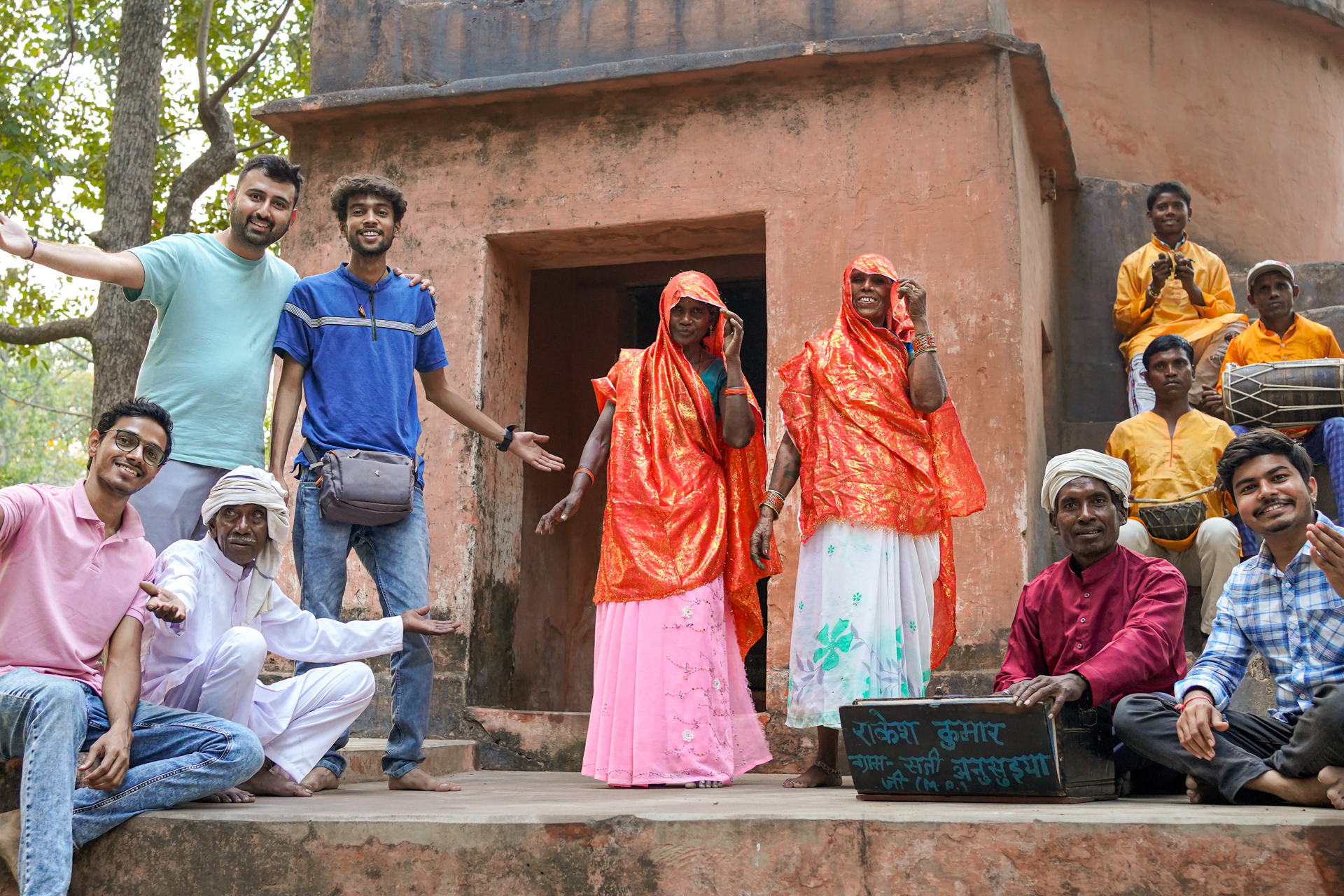
The Bhajans and Dance of the Kol Adivasis
Kol Adivasis are mentioned in the Ramayana, and their bhajans and other folk songs are closely related to the life of Lord Ram.
Away from the hustle-bustle of Markundi, a small town in the Chitrakoot district of Uttar Pradesh, located right next to a small stream lies the Markandey Ashram, a hermitage dedicated to the sage Markandey. Bhargava Markandey is an important sage in Hindu traditions and is mentioned frequently in both the Bhagavata Purana and the Mahabharata. He is believed to be an ardent devotee of Shiva; hence, an ancient Shiva temple exists within the premises. The ashram is also considered one of the places Lord Ram visits during the vanavaasa, his banishment into the forest. It is here that Dadulal and his group performed folk songs about the Kol Adivasi tribe.
The Kol Adivasis are a tribal population who live in this region and share a very special connection to the Ramayana. They are held to be one of the oldest inhabitants of the subcontinent. They are also very significant in the religion of North India because of their mention in the Ramayana. Their folk songs also reflect this aspect, as they frequently mention Ram, Sita, Lakshmana and Hanuman and draw upon the stories from the epic. Being a tribal population, the community doesn’t have a long historical account, but their history mainly survives in oral traditions such as folk music. For this reason, their folk songs are an important, intangible cultural asset of our country that preserves the lesser-known history and lives of this tribe.
Dadulal is 72 years old but has the spirit and enthusiasm of a little child. Right from 12, he instinctively knew that he had to learn singing and music. He fondly remembers his childhood in his village, where he was inspired by the Phagwa, Dewari, Rai and Balma performances and learnt to sing and play the instruments by himself. He charmingly remembers how he would imitate Dholak players in his childhood by patting his hands on his stomach and learnt the rhythms that way. In addition to Dholak, he also learnt to play the Nagada and can somewhat play the Harmonium, but singing along with playing the Dholak is what he enjoys the most right now.
The group performs songs that are unique to the Kol people. Kolhai is a folk song that is performed all night during weddings to celebrate the coming of the groom. The song also has another important aspect of their history. Historically, the Kol people lived in poverty for much of their existence, away from society in the forests. They didn’t even have clothes to wear, and when it got very cold in the winter, they lit up bonfires and sang songs all night to distract themselves.
The group also performs Rai in the Chattarpuri variant, whose language differs slightly from the better-known Bundeli variant. When asked to explain this further, Dadulal starts singing – “Are phir se miliyo aar, aayi na maza pehla pehel mein, phir se miliyo aar” – this is Bundeli Rai. Chattarpuri Rai, which is unique to Chitrakoot region, goes like this – “Mori gaghariya ka thanda paani, are dheere se boro adaayo na, paani bina tarsayo na”. It’s a playful genre to celebrate happiness. A master of improvisation, Daadulal often mixes different genres to broaden the appeal of his songs. Like, he has further sung the Rai song by mixing it with Banra, another Bundeli folk genre – “Shivo shankar maharaj-i aaj dulha bane aayi re, more shiv shankar maharaj-i aaj dulha bane aayi re, mori gaghariya ka thanda paani, are dheere se boro adaayo na, paani bina tarsayo na.” This had his whole group laughing in amusement. He compares composing music to cooking. Just like serving food with chutney and other side dishes makes it more delicious, music must also be performed with many flavours.
Having been a musician all his life, he is well-versed in the folk genres and has the creative energy of a child when it comes to intermixing them. He also knows a lot of poems and verses, which he spontaneously sings in his songs to add to their flavour.
Also in the group is Dadulal’s son, Ram Bahori, who sings and plays the Manjhira alongside his father. He also serves as the group’s manager and finds shows and performances. Shivam is only 20 years old and is the youngest in the group. Having been inspired by music since childhood, he now wants to learn music from Dadulal. Bela and Sukaliya are both elderly women in their late 50s who dance and also join as chorus singers. The group is particularly active in singing Ram-Sita bhajans at temple festivals and celebrations. The Kol tribe enjoys a special connection with the life of Lord Rama, and hence they specialise in singing songs dedicated to him.
Members of the group, including Ram Bahori, are also active in social and political campaigning for the Kol Adivasis. They explained that their tribe is considered a Scheduled Tribe in Madhya Pradesh but not in Uttar Pradesh. They have been campaigning to include the Kol people also in the list of Scheduled Tribes so they get the rights to the forest. They have also performed in government cultural programs.
Dadulal believes music is his people’s most important form of expression, and it must be kept alive. The tribe’s long history and traditions are preserved in their folk music which is an integral part of their identity.
